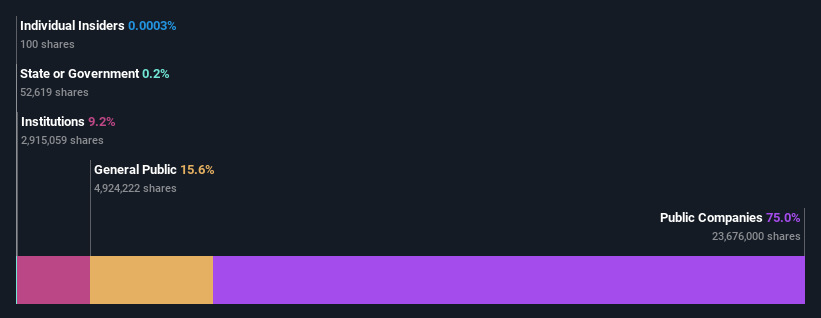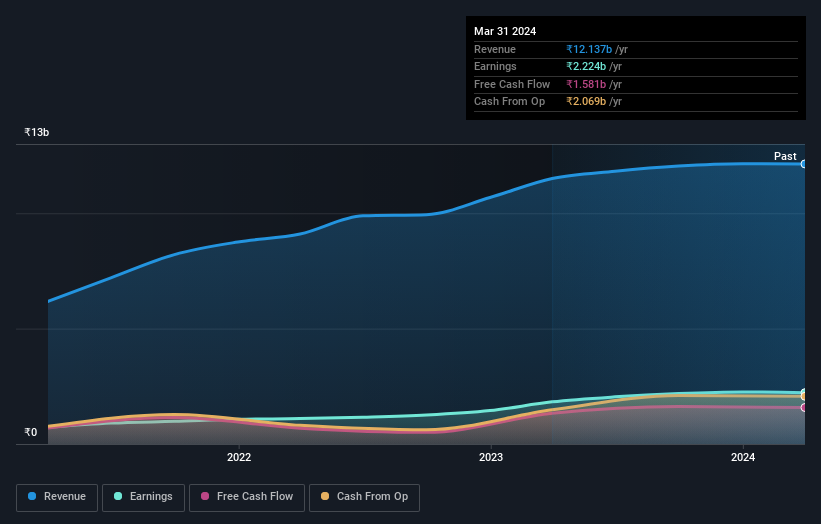Ingersoll-Rand (India) Limited's (NSE:INGERRAND) largest shareholders are public companies who were rewarded as market cap surged ₹6.5b last week
Key Insights
- The considerable ownership by public companies in Ingersoll-Rand (India) indicates that they collectively have a greater say in management and business strategy
- The largest shareholder of the company is Ingersoll Rand Inc. with a 75% stake
- Past performance of a company along with ownership data serve to give a strong idea about prospects for a business
To get a sense of who is truly in control of Ingersoll-Rand (India) Limited (NSE:INGERRAND), it is important to understand the ownership structure of the business. The group holding the most number of shares in the company, around 75% to be precise, is public companies. That is, the group stands to benefit the most if the stock rises (or lose the most if there is a downturn).
As a result, public companies were the biggest beneficiaries of last week’s 4.5% gain.
Let's take a closer look to see what the different types of shareholders can tell us about Ingersoll-Rand (India).
View our latest analysis for Ingersoll-Rand (India)

What Does The Institutional Ownership Tell Us About Ingersoll-Rand (India)?
Institutional investors commonly compare their own returns to the returns of a commonly followed index. So they generally do consider buying larger companies that are included in the relevant benchmark index.
As you can see, institutional investors have a fair amount of stake in Ingersoll-Rand (India). This suggests some credibility amongst professional investors. But we can't rely on that fact alone since institutions make bad investments sometimes, just like everyone does. It is not uncommon to see a big share price drop if two large institutional investors try to sell out of a stock at the same time. So it is worth checking the past earnings trajectory of Ingersoll-Rand (India), (below). Of course, keep in mind that there are other factors to consider, too.

Ingersoll-Rand (India) is not owned by hedge funds. Ingersoll Rand Inc. is currently the company's largest shareholder with 75% of shares outstanding. With such a huge stake in the ownership, we infer that they have significant control of the future of the company. Meanwhile, the second and third largest shareholders, hold 3.2% and 2.9%, of the shares outstanding, respectively.
While it makes sense to study institutional ownership data for a company, it also makes sense to study analyst sentiments to know which way the wind is blowing. Our information suggests that there isn't any analyst coverage of the stock, so it is probably little known.
Insider Ownership Of Ingersoll-Rand (India)
The definition of an insider can differ slightly between different countries, but members of the board of directors always count. Management ultimately answers to the board. However, it is not uncommon for managers to be executive board members, especially if they are a founder or the CEO.
I generally consider insider ownership to be a good thing. However, on some occasions it makes it more difficult for other shareholders to hold the board accountable for decisions.
Our data suggests that insiders own under 1% of Ingersoll-Rand (India) Limited in their own names. Keep in mind that it's a big company, and the insiders own ₹480k worth of shares. The absolute value might be more important than the proportional share. Arguably, recent buying and selling is just as important to consider. You can click here to see if insiders have been buying or selling.
General Public Ownership
The general public, who are usually individual investors, hold a 16% stake in Ingersoll-Rand (India). While this size of ownership may not be enough to sway a policy decision in their favour, they can still make a collective impact on company policies.
Public Company Ownership
We can see that public companies hold 75% of the Ingersoll-Rand (India) shares on issue. We can't be certain but it is quite possible this is a strategic stake. The businesses may be similar, or work together.
Next Steps:
It's always worth thinking about the different groups who own shares in a company. But to understand Ingersoll-Rand (India) better, we need to consider many other factors. Consider risks, for instance. Every company has them, and we've spotted 1 warning sign for Ingersoll-Rand (India) you should know about.
Of course this may not be the best stock to buy. Therefore, you may wish to see our free collection of interesting prospects boasting favorable financials.
NB: Figures in this article are calculated using data from the last twelve months, which refer to the 12-month period ending on the last date of the month the financial statement is dated. This may not be consistent with full year annual report figures.
New: AI Stock Screener & Alerts
Our new AI Stock Screener scans the market every day to uncover opportunities.
• Dividend Powerhouses (3%+ Yield)
• Undervalued Small Caps with Insider Buying
• High growth Tech and AI Companies
Or build your own from over 50 metrics.
Have feedback on this article? Concerned about the content? Get in touch with us directly. Alternatively, email editorial-team (at) simplywallst.com.
This article by Simply Wall St is general in nature. We provide commentary based on historical data and analyst forecasts only using an unbiased methodology and our articles are not intended to be financial advice. It does not constitute a recommendation to buy or sell any stock, and does not take account of your objectives, or your financial situation. We aim to bring you long-term focused analysis driven by fundamental data. Note that our analysis may not factor in the latest price-sensitive company announcements or qualitative material. Simply Wall St has no position in any stocks mentioned.
Have feedback on this article? Concerned about the content? Get in touch with us directly. Alternatively, email editorial-team@simplywallst.com
About NSEI:INGERRAND
Ingersoll-Rand (India)
Manufactures and sells industrial air compressors and related services in India.
Flawless balance sheet with solid track record.
Market Insights
Community Narratives



